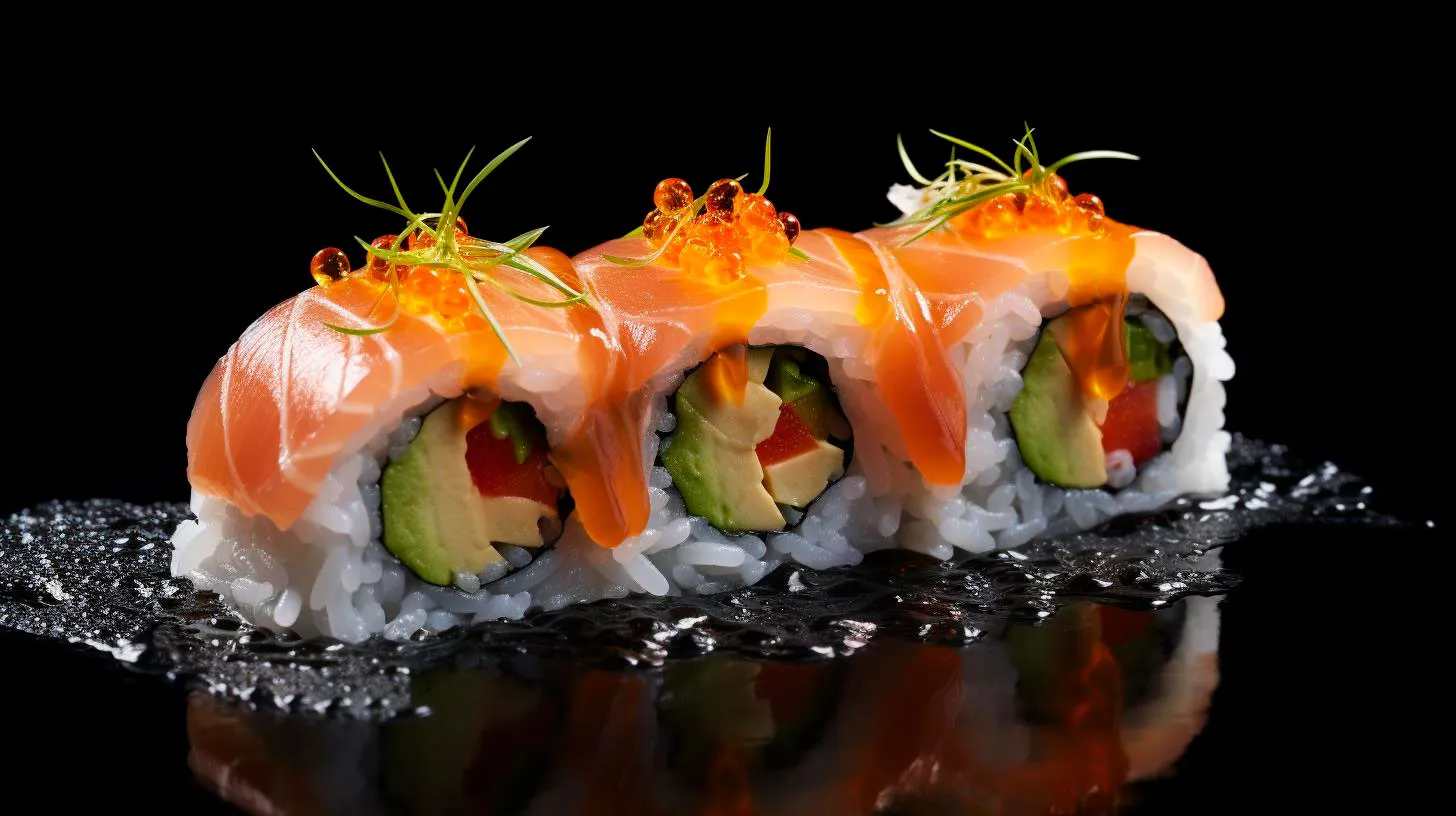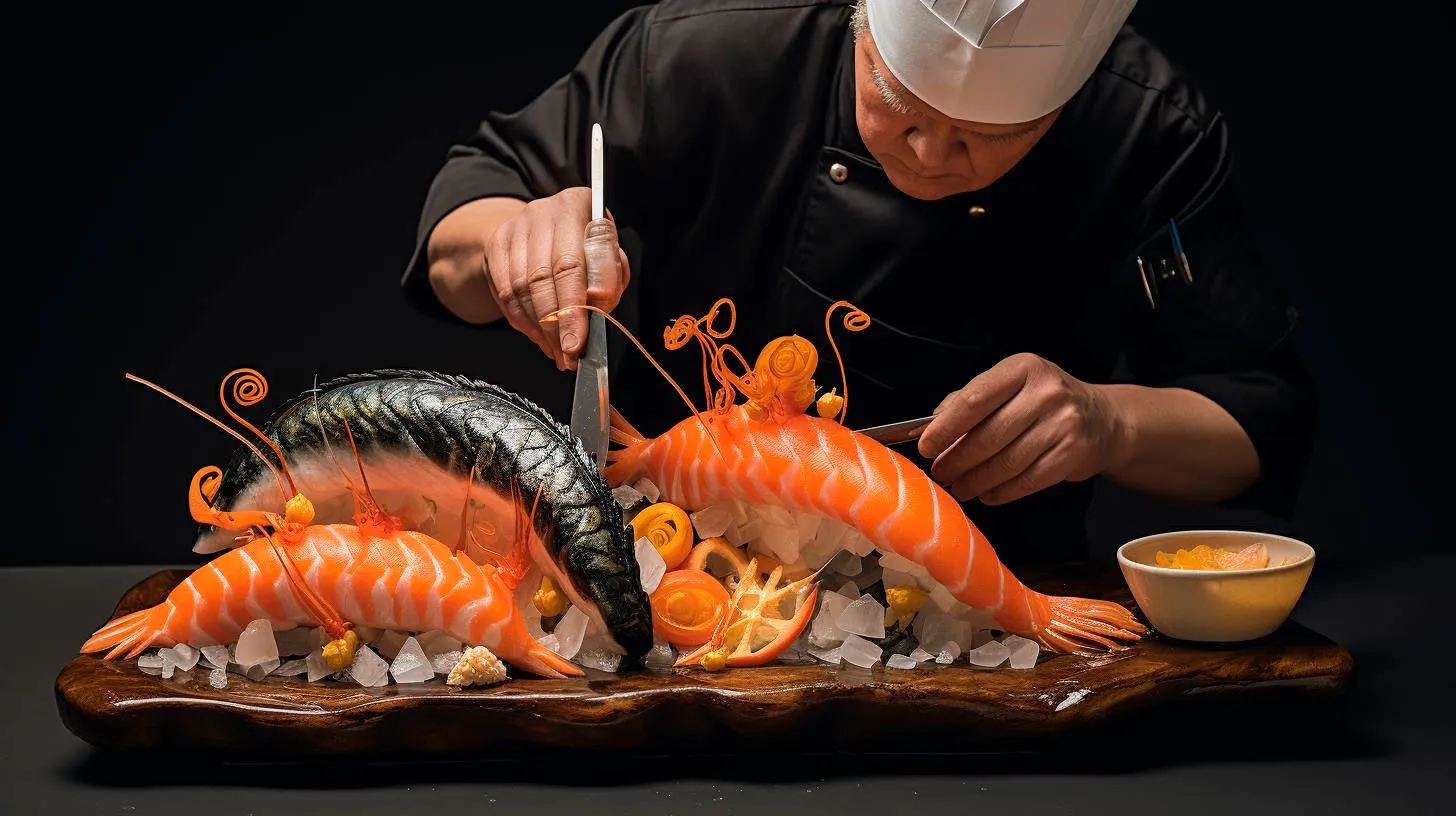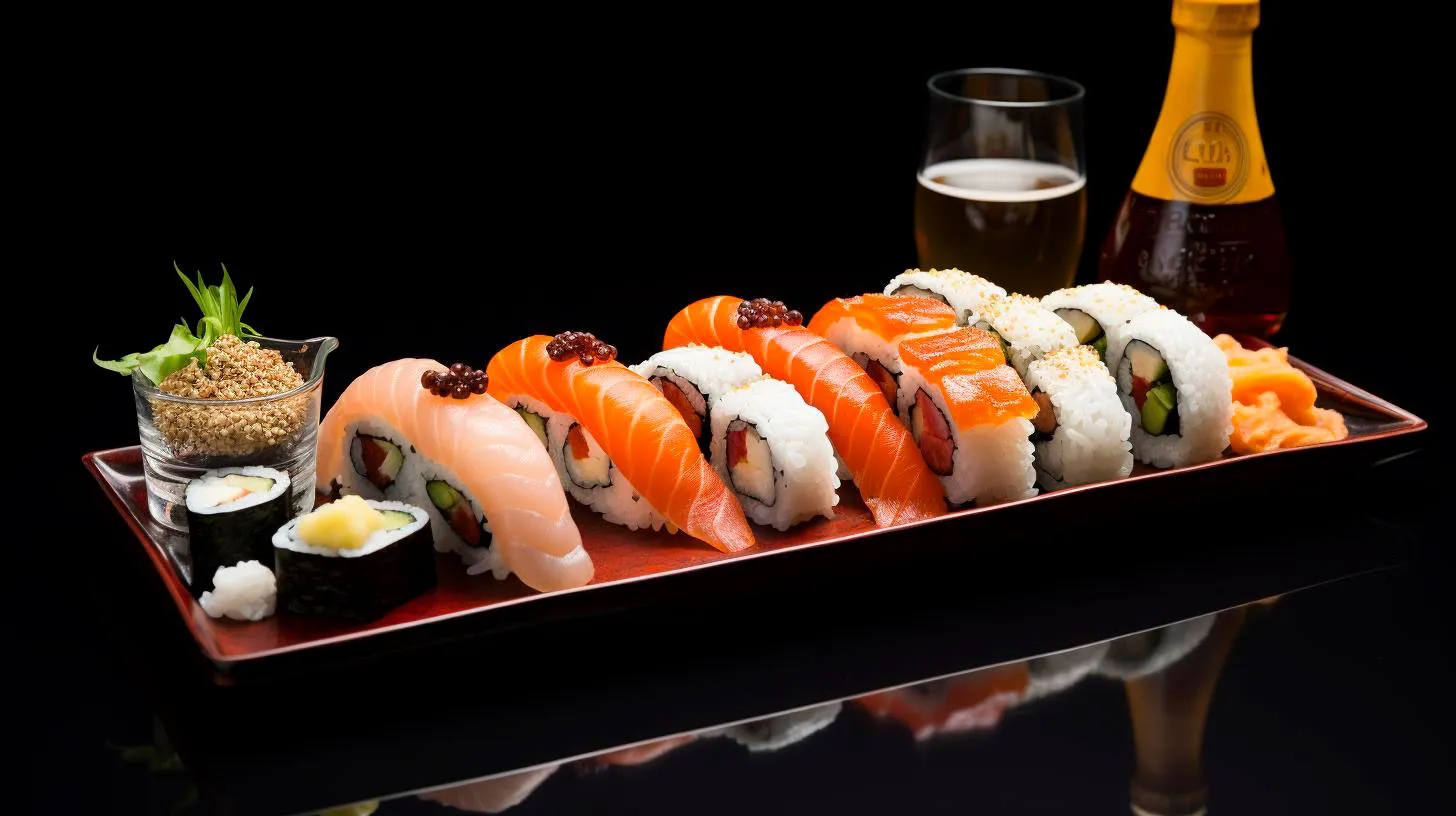Understanding the Different Types of Sushi Rolls and Ingredients
In this article, we will explore the various types of sushi rolls that you can find in Japanese restaurants and provide insights into their key ingredients and significance.
1. Maki Rolls
Maki rolls are one of the most common types of sushi rolls, and they are characterized by their cylindrical shape. These rolls consist of sushi rice, seaweed (nori), and a variety of fillings. The rolls are wrapped in nori, and then sliced into bite-sized pieces. Maki rolls can be enjoyed as a vegetarian option or made with meat, seafood, or a combination of ingredients.
Key takeaways:
- Maki rolls are cylindrical in shape.
- They are made with sushi rice, nori, and various fillings.
- They can be vegetarian or contain meat, seafood, or combinations.
2. Nigiri Sushi
Nigiri sushi is a classic sushi style that consists of a slice of raw or cooked fish, seafood, or tamago (sweet Japanese omelet) placed on top of a small mound of sushi rice. The simplicity of nigiri allows the delicate flavors of the fish or other toppings to shine through. Nigiri sushi is often served with a small amount of wasabi between the fish and rice, and sometimes garnished with a thin strip of nori. It is typically enjoyed by dipping it lightly into soy sauce.
Key takeaways:
- Nigiri sushi is a slice of fish or seafood on a bed of sushi rice.
- Toppings can be raw or cooked fish, seafood, or tamago.
- Usually served with wasabi and soy sauce.
3. Temaki Rolls
Temaki rolls, also known as hand rolls, are cone-shaped sushi rolls that are wrapped in nori. They are typically larger than maki rolls and are meant to be eaten with your hands. Temaki rolls are filled with sushi rice, vegetables, seafood, and other ingredients. These rolls can be easily customized by adding your favorite fillings and condiments. The unique shape of temaki rolls makes them a fun and interactive option for sushi lovers.
Key takeaways:
- Temaki rolls are cone-shaped and wrapped in nori.
- They are larger than maki rolls and eaten with hands.
- Can be filled with sushi rice, vegetables, seafood, etc.
4. Uramaki Rolls
Uramaki rolls, also known as inside-out rolls, are a popular choice for sushi lovers who prefer a milder taste. In this type of roll, the rice is on the outside and the nori is on the inside. Uramaki rolls are often topped with sesame seeds or tobiko (flying fish roe) for added texture and flavor. The fillings can range from traditional ingredients like cucumber, avocado, and crab meat to more creative combinations. Uramaki rolls are visually appealing and offer a different eating experience due to the reversed order of rice and nori.
Key takeaways:
- Uramaki rolls have rice on the outside and nori on the inside.
- Toppings often include sesame seeds or tobiko.
- Fillings can vary from traditional to creative combinations.
5. Sashimi
Although not technically a sushi roll, sashimi is an integral part of Japanese cuisine and often served alongside sushi. Sashimi is thinly sliced, raw fish or seafood that is served without rice. It allows the pure flavors of the fish to take center stage. The most popular types of fish used for sashimi include tuna, salmon, yellowtail, and octopus. Sashimi is usually served with soy sauce and wasabi to enhance the flavors.
Key takeaways:
- Sashimi is thin slices of raw fish or seafood served without rice.
- Promotes the pure flavors of the fish.
- Popular fish types for sashimi include tuna, salmon, yellowtail, and octopus.
By understanding the different types of sushi rolls and their ingredients, you can make informed choices when ordering sushi. Whether you prefer the simplicity of nigiri or the variety of maki rolls, there is a sushi option to suit every palate. So, the next time you visit a Japanese restaurant, dive into the world of sushi and explore the flavors and textures that make this cuisine so beloved!
Etiquette for Eating Sushi in a Traditional Setting
In this article, we will explore the essential etiquette for eating sushi and provide you with key takeaways to ensure a memorable and respectful dining experience.
1. Choosing the Right Chopsticks
When dining at a traditional sushi restaurant, it is important to use chopsticks instead of your hands. If you are unfamiliar with using chopsticks, practice beforehand to avoid any embarrassing moments during your meal. Remember these points:
- Use disposable chopsticks or bring your own set if you are a frequent sushi eater.
- Avoid rubbing your chopsticks together as it may be seen as a sign of disrespect to the chef.
- When not using your chopsticks, rest them on the chopstick holder or on the side of the plate.
2. Properly Using Soy Sauce
Soy sauce is a staple condiment when enjoying sushi. However, it is crucial to use it in the right manner to appreciate the flavors and respect the sushi chef’s craftsmanship. Here’s what you should keep in mind:
- Pour a small amount of soy sauce into the soy sauce dish provided.
- Dip the fish side, not the rice side, into the soy sauce to prevent the rice from falling apart.
- Avoid soaking the sushi in soy sauce as it can overpower the delicate flavors.
- Refrain from adding wasabi directly into the soy sauce dish, as it is disrespectful to the chef’s preferred balance of flavors.
3. Savoring Sushi in One Bite
Traditionally, sushi is meant to be enjoyed in one bite. This allows you to fully experience the chef’s intention for each piece of sushi. Take note of the following:
- Use your chopsticks or fingers to pick up a piece of sushi.
- Avoid biting the sushi in half or taking multiple small bites.
- Try to consume the sushi within a few seconds to relish the freshness and texture.
4. Appreciating the Chef’s Selection
When sitting at the sushi bar, it’s common to let the chef decide what to serve you. This allows the chef to showcase their skills and serve you the freshest ingredients of the day. Show your appreciation by:
- Refraining from requesting modifications to the chef’s selection.
- Expressing gratitude for every dish served by saying “Arigatou gozaimasu” (Thank you) to the chef.
- Engaging in conversation with the chef if they are open to it, as it adds to the overall experience.
5. Mindful Table Manners
In addition to the specific sushi etiquette, general table manners are also important. Follow these guidelines:
- Avoid placing your chopsticks directly on the tabletop, as it is considered impolite.
- Do not wave your chopsticks around or use them as a pointing utensil.
- When using communal dishes, only serve yourself what you can eat to avoid wasting food.
- Do not blow your nose at the table; it is considered rude. Excuse yourself and use the restroom if needed.
By respecting these etiquette guidelines, you can fully immerse yourself in the traditional sushi dining experience and show appreciation for the chef’s craftsmanship. Remember, sushi is not just about the taste; it is about the rich history and culture that accompanies it.
Key Takeaways:
- Using chopsticks instead of hands is essential in a traditional sushi setting.
- Pour a small amount of soy sauce and dip only the fish side.
- Enjoy each sushi piece in one bite to appreciate the flavors.
- Let the chef decide what to serve and show gratitude for their selection.
- Follow general table manners to display respect towards the dining experience.
Now, armed with the knowledge of proper sushi etiquette, you can confidently indulge in this exquisite culinary experience while paying homage to the rich Japanese culture.
How to Properly Use Chopsticks at a Japanese Restaurant
In this article, we will guide you through the process of properly using chopsticks, ensuring a more enjoyable and authentic dining experience.
The Art of Holding Chopsticks
Before we delve into the techniques of using chopsticks, it’s crucial to understand how to hold them correctly. Follow these steps:
- Hold one chopstick with your dominant hand, grasping it between your thumb and your index finger.
- Place the other chopstick above the first one, holding it between your index and middle fingers.
- Rest the lower chopstick on the base of your thumb, while the upper chopstick should rest on the tip of your thumb and index finger.
- Keep the chopsticks parallel to each other, allowing for easy maneuverability.
Remember, practice makes perfect. It may take a few attempts to get the hang of it, but with consistent effort, you’ll be able to hold chopsticks effortlessly.
The Pinching Technique
Once you have mastered holding the chopsticks, it’s time to move on to the pinching technique. Follow these steps:
- Hold the chopsticks about one-third of the way from the top.
- Use your thumb to keep the upper chopstick in place.
- Move the lower chopstick using your index and middle fingers.
It’s important to remember that chopsticks are primarily used for grabbing or pinching food, not for impaling or spearing it. Gentle and controlled movements are key to successfully picking up your desired dish.
Practical Tips for Using Chopsticks
Here are some additional tips to ensure a smooth dining experience:
- Practice with different types of food, such as rice, noodles, or small vegetables, to improve your dexterity.
- Keep your chopsticks clean and dry to maintain a firm grip.
- Avoid waving or pointing with chopsticks, as it is considered impolite.
- Rest your chopsticks on the designated chopstick rest when not in use.
- Don’t use your chopsticks to pass food to others; instead, use the provided serving utensils.
The Advantages of Using Chopsticks
Using chopsticks offers several advantages beyond the cultural aspect. Here are a few to consider:
- Precision: Chopsticks provide a level of precision that allows you to carefully pick up even the smallest pieces of food.
- Portion control: The use of chopsticks encourages mindful eating and portion control, as you need to take smaller bites.
- Health benefits: Picking up food with chopsticks keeps your hands clean, reducing the risk of contamination.
- Environmental friendliness: Unlike disposable utensils, chopsticks can be reused, making them a sustainable option.
Key Takeaways
Mastering the art of using chopsticks at a Japanese restaurant not only enhances your dining experience but also showcases your cultural sensitivity. Here are the key takeaways:
- Hold your chopsticks correctly, with the lower chopstick resting on the base of your thumb and the upper chopstick held by your index and middle fingers.
- Use the pinching technique to pick up food, ensuring controlled and gentle movements.
- Practice regularly to improve your dexterity and become more proficient in using chopsticks.
- Remember the practical tips, such as keeping your chopsticks clean, resting them when not in use, and avoiding impolite gestures.
- Appreciate the advantages of using chopsticks, including precision, portion control, hygiene, and environmental sustainability.
By following these guidelines and mastering the art of using chopsticks, you can fully immerse yourself in the authentic dining experience offered by Japanese cuisine. Enjoy exploring the rich flavors and traditions that await you!



